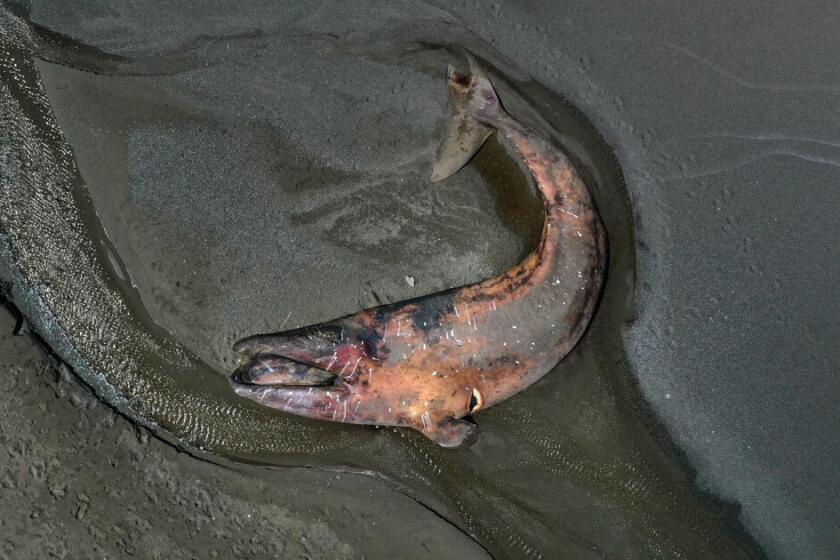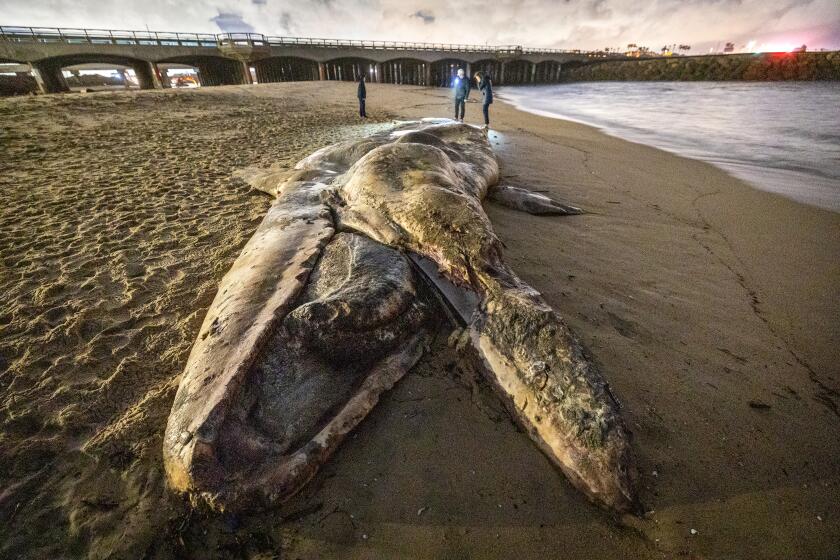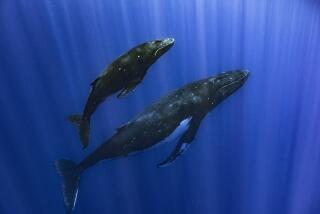
When large numbers of gray whales began washing up along North America’s Pacific Coast nearly six years ago, marine scientists could only speculate at the reason: Was it disease? Ocean pollution? Increasing ship collisions?
Many of the doomed cetaceans looked skinny or emaciated, while others looked torn up by orcas. Some had clearly died after being struck by a ship, or getting entangled in fishing gear. Still others provided no discernible clues.
Now — after more than 700 gray whales have washed ashore in Mexico, Canada, California and other U.S. states since late 2018 — new research published Tuesday in PLOS One suggests the culprit was a critical drop in food availability in the mammals’ Arctic and sub-Arctic seafloor feeding grounds.
What remains unclear however is whether this malnutrition was caused by a change in the ocean, or the whales themselves.
Aggressive and impactful reporting on climate change, the environment, health and science.
“Did something happen to their food supply in those years that put them under acute nutritional stress and which resulted in a lot of whales being in really poor condition and dying?” said study co-author Padraig Duignan, a pathologist at the Marine Mammal Center in Sausalito.
“Or did the number of whales in the population build up to such a level that they have competed with each other for food and then again, a proportion of the population died off because they couldn’t compete for the available resources?” he said.
The research builds on an investigation that the National Oceanic and Atmospheric Administration launched in early 2019, after declaring the whale deaths an unusual mortality event, or UME. Researchers, observers and stranding coordinators across North America began working together — alerting one another to strandings; sending crews to document and collect tissue samples; and performing necropsies (the animal form of an autopsy).
The NOAA investigation recorded 690 dead whales since Jan. 1, 2019. However, researchers suspect the true number is thousands more than that. Most whales die at sea and sink to the seafloor, far beyond the sight or reach of humans.
Joshua Stewart, a quantitative ecologist at Oregon State University’s Marine Mammal Institute, who was not an author on the paper, estimates the gray whale population was reduced by half during the most recent mortality event.
“The population is 14,000 down from 27,000 or so,” he said. “That’s a big drop.”

NOAA declared last week that the die-off was over.
Every year, California gray whales make a roughly 13,000-mile round-trip journey from the chilly waters of the Arctic to the balmy lagoons of Mexico’s Baja Peninsula, and back again. During the summer months, they feed on a smorgasbord of bottom-dwelling invertebrates, such as shrimp-like copepods, that flourish in the mud and sand of the Bering, Chukchi and Beaufort seas. Here they mate and fill their bellies, readying themselves for the long trip south to the warm, protected nurseries of the shallow Baja estuaries.
Along the way, they dodge ships and fishing equipment, navigate polluted waters, and hide from hungry orcas. They also have to contend with biotoxins and infectious diseases.
So when researchers began looking at the whales’ bodies, they tried to determine which of these various calamities was the primary cause of the population die-off.
Although other gray whale die-offs have occurred along the Pacific Coast, they have been less closely researched.
In 1999 and 2000, 651 whales stranded onshore, but only three whales were necropsied. Another die-off in the late 1980s was studied even less.
Between 2018 and 2023, hundreds of gray whale carcasses washed up along the West Coast. A food shortage led to the phenomenon, which is over, scientists say.
This time, however, the scientific investigative team was large — spread across three nations — highly coordinated, and had access to new technologies, such as drones, which enabled them to create a more thorough picture of the whales that died, and those that remained alive.
“I think funding was a big part of it as well,” said Stephen Raverty, a veterinary pathologist with the Marine Mammal Research Unit in British Columbia, and lead author of the study. “It’s really afforded an opportunity to respond to these animals. And then we’re always trying to get the information back to the First Nations community or sharing it with the public. And I think that engages more people to actually want to contribute and participate in these efforts.”
He also gave a nod to co-author Deborah Fauquier, a veterinary medical officer with the national fisheries service’s Office of Protected Resources in Silver Spring, Md. He said Fauquier was instrumental in organizing the sharing of information across nations, departments and individuals.
But even with such resources, studying whale die-offs is difficult.
Despite the hundreds of whales that washed ashore, researchers could only properly examine 61.
That’s because the majority of reported carcasses were either discovered weeks or months after the animal had died — and were far too decomposed for proper analysis — or they were located on remote islands, inaccessible coves, or the prows of ships at sea.

Of the 61 whales they examined, researchers determined the cause of death in just over half. Sixteen were severely emaciated and likely died of starvation; 11 died of blunt force trauma — although two of those whales were also extremely underweight; at least three bore fatal wounds from killer whales and two were tangled in fishing gear.
Overall, 18 whales were considered emaciated, 27 deemed “thin,” nine average and two fat. In the five others, nutritional state could not be determined.
One thing that was clear: The die-off wasn’t due to disease.
Large animal die-offs are often due to biotoxins, viruses or bacterial infections. The avian flu currently circulating around the globe is one example. The domoic acid outbreak during the summer of 2023, which killed hundreds of sea lions and dolphins, is another.
“We didn’t find any evidence of anything that looks like an infectious disease,” said Duignan. “There were no telltale signs of infection of any kind. And we did do a lot of testing for viruses, bacteria, toxins, and there was nothing significant.”
What is driving the unprecedented spread of avian flu?
Now the question is whether the gray whale population will recover or continue to decline, or whether the now-depleted population has reached a new optimal size that can take advantage of the massive changes occurring in their summer feeding grounds.
Raverty noted that during this latest investigation, reports of unusual feeding behavior by the whales was observed relatively frequently. While the biological mantra had always been that gray whales feed only on bottom-dwelling organisms in the northern seas during the summer months — and fast for the rest of the year — reports came in of gray whales filter feeding and skimming krill off the surface, in places such as San Francisco Bay.
The ability of gray whales to adapt has long been known — but the frequency with which these behaviors were occurring suggested to some an immediate adaptive reaction to lack of food, or possibly behaviors no one had ever really paid heed.
That’s partly what is so exciting about this research, said Raverty. It enabled scientists to build a baseline upon which they can now make comparisons.
“If we look at another five or 15 years, if we get another recurrence,” he said, they’ll have this data with which to compare.
As for the future and population recovery?
“The way I think about this is ... these whales aren’t going away. They’re not going to go extinct,” Stewart said. “But if the environment becomes much more marginal, we might just not see as many whales as we have had in the past when we had really robust, productive Arctic [seafloor] habitats.”
Toward a more sustainable California
Get Boiling Point, our newsletter exploring climate change, energy and the environment, and become part of the conversation — and the solution.
You may occasionally receive promotional content from the Los Angeles Times.











